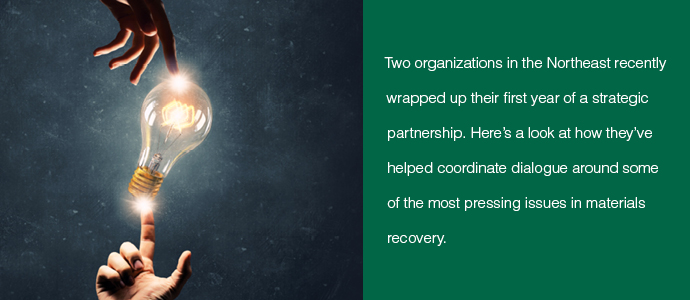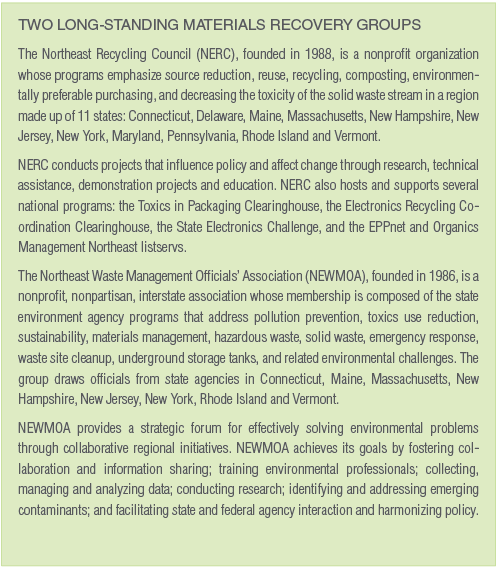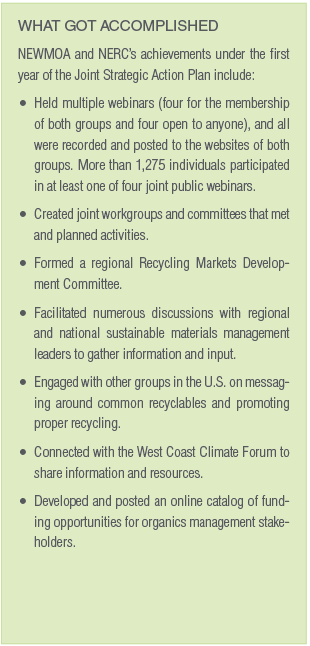
This article appeared in the February 2019 issue of Resource Recycling. Subscribe today for access to all print content.
In June 2017, the Northeast Recycling Council (NERC) and the Northeast Waste Management Officials’ Association (NEWMOA) entered into a Joint Strategic Action Plan to strengthen their collaboration and to seek opportunities for materials recovery advancement.
NEWMOA and NERC have extensive expertise and several decades of experience taking action on materials management (see sidebar on p. 37). At times, various entities have asked about the distinctions between the organizations and opportunities to collaborate. The Joint Strategic Action Plan addresses both of these important questions and articulates a future vision of success in fulfilling both groups’ missions built upon collaboration and expertise sharing.
Over its first year, this first-of-its kind effort resulted in remarkable progress. NERC and NEWMOA took significant steps to boost dialogue and coordinate stakeholders around issues that are impacting materials management programs right now as well as those that will be increasingly pertinent to decision-makers in the years ahead.
“We are at a critical time in the management of solid waste,” said Chuck Schwer, director of the Waste Management Division at the Vermont Department of Environmental Conservation, “with the challenges caused by the China Sword policy, the growing national interest in managing food waste and a changing climate that threatens the resiliency of solid waste management infrastructure. Forming this partnership has allowed the region to bring together the experts to help navigate these challenging times.”
Below is a summary of first-year accomplishments in six realms targeted by the NERC-NEWMOA alliance.
Action around food scraps
To support both groups’ efforts to reduce food loss and improve diversion to compost and anaerobic digestion, NEWMOA’s existing Food Waste Workgroup expanded to include NERC membership. The workgroup includes representatives of state and federal government environmental agencies in the region that are focused on food loss and waste challenges.
The joint workgroup held multiple calls to share updates, information, resources and tools. It also worked to plan activities. As a result of these conversations, NERC and NEWMOA held a webinar in March 2018 for members of both organizations that was called “Addressing the Confusing Landscape of Compostable Products.” Presenters included Dan Goossen of Green Mountain Compost, David Mrgich of the Maryland Department of the Environment and Mark Williams of BioBag USA.
 The PowerPoint presentations and a recording of the webinar are available on both the NEWMOA and NERC websites.
The PowerPoint presentations and a recording of the webinar are available on both the NEWMOA and NERC websites.
In addition, both organizations believe that funding for expanding food waste diversion infrastructure is critical. To address this need, NERC created and posted a catalog of funding opportunities for a variety of stakeholders involved in the food scrap chain, including developers of food de-packaging technologies/facilities and operators of anaerobic digestion and composting sites. NERC’s document is called the “Directory of Government Based Financial Assistance for Organics-Related Businesses” and is available online.
On the organics outreach front, NEWMOA and NERC are concerned about challenges the public faces when it comes to understanding the various symbols and images used by local and state programs for organics collection. To address this issue, the organizations held a webinar in May 2018 for their boards and program staff. It involved participants from numerous states, who shared information and discussed next steps.
Presenters included Josh Kelly of the Vermont Department of Environmental Conservation, Sherrill Baldwin from Connecticut’s Department of Energy and Environmental Protection (DEEP), and Krystal Noiseux of the Rhode Island Resource Recovery Corporation
As an outgrowth of this webinar, NEWMOA and NERC began to focus on harmonizing organics and recycling collection images and symbols. This action included coordination with Keep America Beautiful, the Institute for Scrap Recycling Industries, the Solid Waste Association of North America, the National Waste and Recycling Association, the U.S. EPA and The Recycling Partnership. The goal is to develop a uniform message about which materials to collect in residential programs and which to direct elsewhere.
The participating groups hope that the results of that effort will be available in 2019.
Cleaning up the stream
As readers of Resource Recycling are well aware, contamination of the recycling stream has become a major challenge. NERC and NEWMOA collaborated throughout the year to support information-sharing and networking to help state leaders address this problem.
NERC and NEWMOA organized and held three widely attended webinars and the recordings for each are available on the groups’ sites. “How to Beat Residential Recycling Contamination” featured presentations from Brooke Nash of the Massachusetts Department of Environmental Protection as well as Chris Coady, Dylan de Thomas and Jason Hale (all of The Recycling Partnership).
Another webinar was titled “On the Ground: Lessons Learned from Municipalities to Reduce Contamination of Residential Recycling.” Presenters included Janice Pare of the Massachusetts Department of Environmental Protection; Marissa Perez-Dormitzer, who represented two Massachusetts municipalities; and Julia Greene, another Massachusetts municipal official.
The final webinar on the contamination topic was “Effective Educational Strategies for Proper Recycling.” It offered insight from Cindy Jolicoeur and Anna DeMers of public relations agency C+C, Tamara Staranchuk from the city of Toronto, and Sherrill Baldwin of Connecticut DEEP.
NERC and NEWMOA have received encouraging feedback on these opportunities for sharing best practices.
“The Joint Strategic Action Plan has provided opportunities to network, share information, and gain knowledge from the expertise and experience of communities, businesses and organizations on key materials management issues,” said Megan Mansfield Pryor, environmental specialist in the Division of Materials Management at the Maine Department of Environmental Protection. “We look forward to continued involvement and collaboration on joint initiatives in the coming year.”
Recycling markets development
Another objective of the organizations has been to reinvigorate efforts to expand markets for key materials.
In 2018, in the face of the industry turmoil as Asian import restrictions came into effect, NERC formed a committee to identify and implement strategies to promote and enhance recycling markets in the Northeast. The Regional Recycling Market Development Committee became a joint committee with NEWMOA after its first meeting, and its initial priority is mixed paper markets. In November of 2018, the committee published a document outlining domestic mill projects with potential to increase use of recycled paper as a feedstock.
In 2018, NERC and NEWMOA also initiated plans for a 2019 workshop for municipal and state highway and public works departments and environmental officials about using recycled content in road and infrastructure projects. The daylong event will focus on case studies by peers who have successfully used shredded tires, glass, ground asphalt shingles, compost, and plastic with post-consumer content in highway and construction projects.
“I look forward to participating in new initiatives in fiscal year 2019, particularly a regional Recycling Markets Development Workgroup that will tackle the most urgent and critical issue in recycling today,” said Kaley Laleker, acting director of the Land and Materials Administration at the Maryland Department of the Environment.
Product stewardship umbrella
The Northeast states have enacted a number of extended producer responsibility (EPR) laws that cover electronics, paint, mattresses, mercury-containing devices, pharmaceuticals and batteries. Legislation has been proposed to bring such laws onto the books in more states in the region, and some proposals have targeted additional product categories, including household hazardous waste, solar panels, tires and various types of packaging.
NEWMOA and NERC have aimed to promote more information-sharing and coordination among the various agencies and organizations in the region that are focused on implementing and expanding these product stewardship initiatives. And the groups have worked on the formation of an umbrella framework for state product stewardship leadership.
To start this effort, NERC and NEWMOA spoke with leading advocates for product stewardship in the region. These inquiries found a high level of interest in the idea of holding regional conversations and providing information-sharing opportunities. The groups held several conference calls with product stewardship leaders in the region, and this coordinated dialogue is anticipated to continue in 2019.
Climate change impacts
In 2017, the Coalition of Northeast Governors (CONEG) released a Climate Action Plan and developed a menu of possible actions that states could take around the issue of a warming world. Not surprisingly, the group identified strategies related to materials and waste.
That work prompted NEWMOA and NERC to form a regional workgroup to discuss climate and materials management steps that states can take as they try to follow CONEG’s recommendations.
NEWMOA organized several calls in 2017 and 2018, and more will take place in 2019. Among other strategies, the workgroup is interested in developing methods to track and report greenhouse gas emission benefits that come through waste reduction, reuse, composting, anaerobic digestion and recycling. To move forward on this effort, the organizations organized two webinars for their boards and other members, with presentations by the Oregon Department of Environmental Quality (known as a leader on the intersection of materials management and environmental impacts). The PowerPoint slides and recordings from these discussions are available on NEWMOA’s website.
NERC and NEWMOA were also interested in strengthening their ties to a long-standing group of West Coast state and federal officials that has been focusing on climate and materials. The group, called the West Coast Climate Forum, involves representatives of environmental agencies in California, Oregon and Washington as well as officials from EPA Regions 9 and 10.
NEWMOA and NERC held several calls with the West Coast Climate Forum to discuss coordination and information-sharing opportunities. All three groups have committed to sharing resources and tools and to promoting each other’s events. They will continue to hold joint calls to stay up-to-date on strategies and activities in 2019.
“Our continued cooperation and joint efforts will only strengthen our resolve within the Northeast to address materials management issues and problems and achieve long-lasting solutions,” said Peter Pettit, director of the Bureau of Waste Reduction and Recycling at the New York State Department of Environmental Conservation.
Solutions for C&D materials
Construction and demolition (C&D) materials make up a large and diverse waste stream, and capacity for recycling and proper management of these materials is a significant struggle in the Northeast.
To support state programs interested in expanding C&D recycling markets, NEWMOA and NERC organized and held a national webinar in January 2018 to share the results of NEWMOA’s C&D materials data analysis and NERC’s project for Massachusetts on C&D materials recycling opportunities.
Presenters on the webinar included Jennifer Griffith of NEWMOA and Ted Siegler and Natalie Star of consultancy DSM Environmental.
More connection on the way
The initial accomplishments of the Joint Strategic Action Plan exceeded expectations of both NERC and NEWMOA. The amount of education and information-sharing that has taken place is reflected in the wealth of material exchanged through the highly attended webinars. This level of collaboration on outreach and information was an aspiration of the plan, and we are delighted by the results.
The 2017–2018 collaboration has resulted in the formation or expansion of several working groups that have developed new ideas and strategies and are having lively discussions and working effectively to address concerns. Many of the ideas that are under discussion for the second year of work under the Joint Strategic Action Plan exceed the vision of the plan drafters. And the groups are organizing more webinars, workshops, meetings and other joint initiatives in fiscal year 2019.
The boards of both organizations have been upbeat about the work done since the plan went into place, in large part because the effort has directly benefited both organizations and their missions. In short, it has encouraged an expansion of the vision of and opportunities for collaboration.
None of the accomplishments under this Joint Strategic Action Plan would have been possible without the dedication and support of the two groups’ boards and membership. Their engagement is critical to the success of both organizations, and we appreciated their ideas and involvement.
“This plan is a wonderful example of the success that can result from a collaborative effort to address challenging and often shared solid waste management issues in the region,” noted Robert Isner, director of the Waste Engineering and Enforcement Division at Connecticut DEEP. “The joint strategic plan directly supports many of DEEP’s environmental, economic, and energy initiatives and priorities.”
Lynn Rubinstein is the executive director of the Northeast Recycling Council (NERC) and can be contacted at [email protected]. Terri Goldberg is the executive director of the Northeast Waste Management Officials’ Association (NEWMOA) and can be contacted at [email protected].


